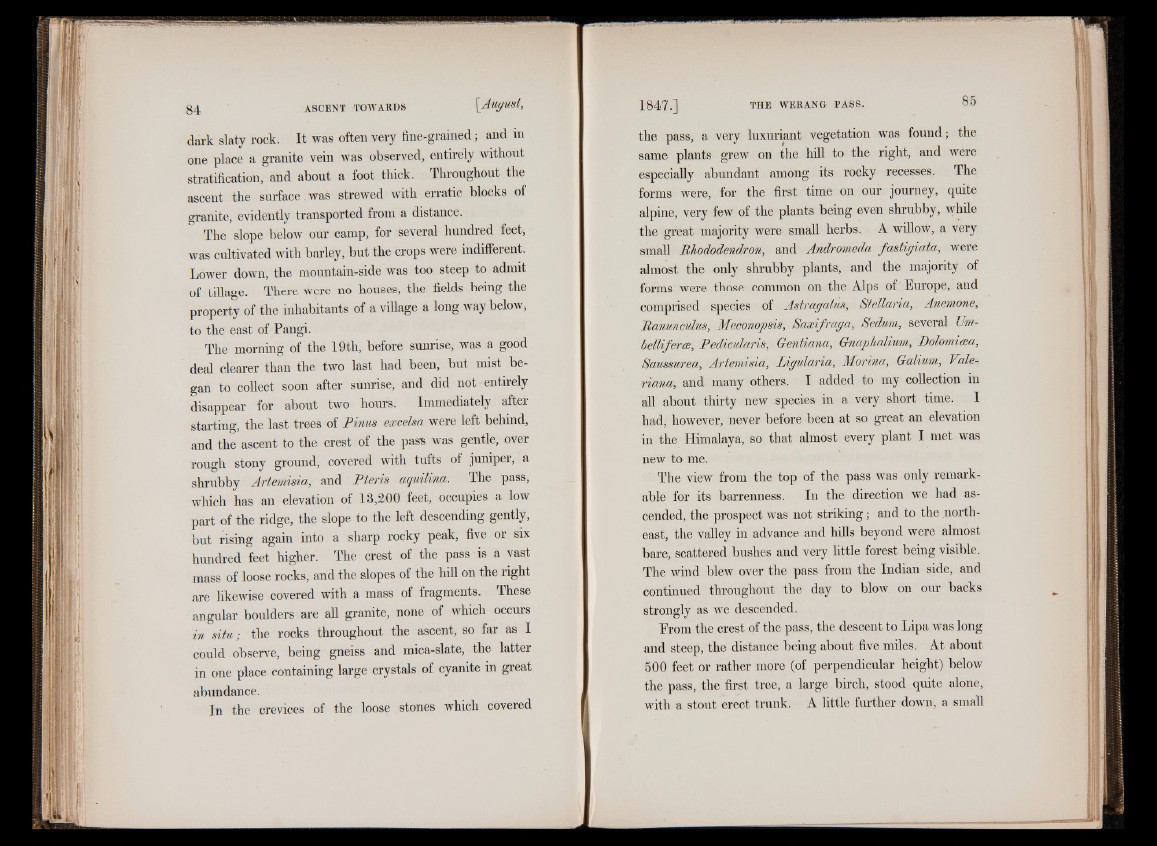
dark slaty rock. It was often very fine-grained; and in
one place a granite vein was observed, entirely without
stratification, and about a foot thick. Throughout the
ascent the surface , was strewed with erratic blocks of
granite, evidently transported from a distance.
The slope below our camp, for several hundred feet,
was cultivated with barley, but the crops were indifferent.
Lower down, the mountain-side was too steep to admit
of tillage. There were no houses, the fields being the
property of the inhabitants of a village a long way below,
to the east of Pangi.
The morning of the 19th, before sunrise, was a good
deal clearer than the two last had been, but mist began
to collect soon after sunrise, and did not entirely
disappear for about two hours. Immediately after
starting, the last trees of Pirns excelsa were left behind,
and the ascent to the crest of the pass was gentle, over
rough stony ground, covered with tufts of juniper, a
shrubby Artemisia, and Pteris aquilina. The pass,
which has an elevation of 18,200 feet, occupies a low
part of the ridge, the slope to the left descending gently,
but rising again into a sharp rocky peak, five or six
hundred feet higher. The crest of the pass is a vast
mass of loose rocks, and the slopes of the hill on the right
are likewise covered with a mass of fragments. These
angular boulders are all granite, none of which occurs
in situ; the rocks throughout the ascent, so far as I
could observe, being gneiss and mica-slate, the latter
in one place containing large crystals of cyanite in great
abundance.
In the crevices of the loose stones which covered
the pass, a very luxuriant vegetation was found; the
same plants grew on the hill to the right, and were
especially abundant among its rocky recesses. The
forms were, for the first time on our journey, quite
alpine, very few of the plants being even shrubby, while
the great majority were small herbs. A willow, a very
small Rhododendron, and Andromeda fastigiata, were
almost the only shrubby plants, and the majority of
forms were those common on the Alps of Europe, and
comprised species of Astragalus, Stellaria, Anemone,
Ranunculus, Meconopsis, Saxifraga, Sedum, several Um-
belliferce, Pedicularis, Gentiana, Gnaphalium, Polomicea,
Saussurea, Artemisia, Ligularia, Morina, Galium, Valeriana,
and many others. I added to my collection in
all about thirty new species in a very short time. I
had, however, never before been at so great an elevation
in the Himalaya, so that almost every plant I met was
new to me.
The view from the top of the pass was only remarkable
for its barrenness. In the direction we had ascended,
the prospect was not striking; and to the northeast,
the valley in advance and hills beyond were almost
bare, scattered bushes and very little forest being visible.
The wind blew over the pass from the Indian side, and
continued throughout the day to blow on our backs
strongly as we descended.
Erom the crest of the pass, the descent to Lipa was long
and steep, the distance being about five miles. At about
500 feet or rather more (of perpendicular height) below
the pass, the first tree, a large birch, stood quite alone,
with a stout erect trunk. A little further down, a small